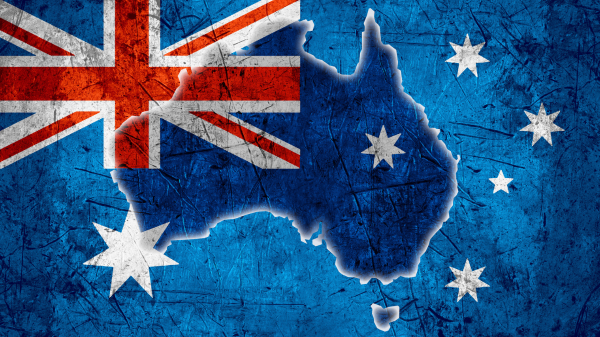IN THIS ISSUE:
- Australia’s Not Quite All in on Net Zero
- Elephant Seal Sites Show Lower Antarctic Ice Extent in the Past
- Poll Shows Americans Still Skeptical of Climate Disaster Claims

Australia’s Not Quite All in on Net Zero
Environmentalists are up in arms over the Australian government’s apparent backsliding on its “net zero by 2050” commitments and the interim targets it set. Although the government hasn’t formally rescinded its commitments, green critics of recent decisions say its actions are speaking louder than its words.
For example, an article in The Conversation says,
The federal government’s decision to extend the life of Woodside’s North West Shelf gas plant in Western Australia has been condemned as a climate disaster.
… the science is clear: no fossil fuel projects can be opened if the world is to avoid catastrophic climate change.
In particular, the government has extended the operational life of the Karratha natural gas plant, part of the enormous North West Shelf liquefied natural gas project, until 2070—20 years past the 2050 net-zero deadline commitment. The Karratha extension is not the only gas project the government has recently greenlit, having approved six more large, heavily capitalized, multibillion-dollar natural gas projects, extending some projects already in operation (including new pipelines and trains to ship gas for LNG exports), and some completely new operations.
The projects all have operating lives extending beyond 2050. Two of the projects would cause 450 and 850 new gas production wells to be brought online, respectively. Collectively, the projects would result in billions of additional tons of carbon dioxide emitted into the atmosphere. Most of the gas would be produced for export, but it doesn’t matter where the gas is burned if one believes CO2 emissions are causing warming; the key is not using it at all, The Conversation points out.
Adding insult to injury from a CO2 emission perspective, in late 2024 Australia’s Labor government also approved four new coal mining projects, working largely under the radar, despite publicly committing earlier in 2024 to disallow any new coal operations.
Australia seems to have a unique way of going net zero: significant expansion of fossil fuel production. Since the current Labor government took power in 2022, it has approved the expansion or creation of 10 new coal projects. Commenting on Australia’s big coal expansion, the World Socialist Web Site writes,
These approvals are just the most recent in a series of decisions that completely contradict Labor’s supposed commitment to take “more ambitious action on climate change.” . . .
Together, the production output from these mines could total 350 million tonnes of coal. The lifetime climate emissions of the three mines are estimated at approximately the equivalent of 936 million tonnes (Mt) of CO2, which is worth over two years of total annual Australian domestic emissions.
That brings the number of coal mine approvals by the Albanese government since taking office in May 2022 to ten. These include the previous approvals for four entirely new coal mines, and expansions to three NSW mines in October. Collectively, the ten approvals will result in an estimated equivalence of 2,449 Mt of CO2 emissions over their lifetime.
It seems that Australia, like many other countries, talks a good green game while recognizing the absolutely critical natural of fossil fuels to job creation and economic growth. They will continue to make up as much as 80 percent of the world’s energy use for decades to come, according to repeated International Energy Agency forecasts. Australia evidently wants its cut of the action. Good for them! It’s time for the Australian government to quit green virtue signaling and follow President Trump’s lead and reject net zero publicly. That would put them on the wrong side of their green constituency, but it would put them on the right side of history and stop opening the government up to claims of hypocrisy.
Sources: World Socialist Web Site; The Conversation

Elephant Seal Sites Show Lower Antarctic Ice Extent in the Past
A recent study of the DNA of Adelie penguins in the Ross Sea and Antarctica has produced some surprising secondary findings about climate conditions there over the Holocene.
Elephant seals breed only in the subantarctic Southern Ocean in waters free of sea ice. It seems that while researching the genetic history of Adelie penguins, scientists found elephant seal DNA from an apparent breeding site on Cape Hallet, more than 2,000 kilometers south of the southernmost viable, active breeding site for the seals during the present day.
Based on copious elephant seal remains found on Cape Hallet, it seems they bred and apparently thrived there during the Roman and Medieval warm periods approximately 2,500 and 1,000 years ago, respectively. This means, of course, that the area was free of sea ice then, which it isn’t now. Based on radiocarbon dating of the remains, the researchers write,
Southern elephant seal breeding colonies are currently restricted to islands within the subantarctic region of the Southern Ocean. However, the discovery of desiccated pup remains and hairs preserved in sediments indicate the species formerly moulted and bred along the Victoria Land Coast from Campbell Glacier in the north to Marble Point in the south. Radiocarbon dating of elephant seal remains from the Victoria Land Coast indicates that reduced sea ice extent between ~ 2500 and 1000 years ago allowed elephant seals to breed at these southern latitudes and attain a large local population before experiencing a local extirpation event that began in the south and progressed northwards as sea ice expanded. The Cape Hallett sedaDNA record provides evidence for a further late Holocene breeding colony site, the northernmost known from the Ross Sea.
This research confirmed findings from a paper published in the journal Marine Mammal Science in 2019, which also found elephant seal remains in the Antarctic region thousands of miles south of where colonies are currently viable because of sea ice conditions.
Antarctic sea ice extent today being greater than in the past is not what is commonly claimed in the mainstream media, but research indicates that’s the truth about the climate in Antarctica, which continues to buck climate model projections and claims of doom.
Source: Nature Communications; No Tricks Zone

Poll Shows Americans Still Skeptical of Climate Disaster Claims
Despite decades of doomsaying about climate change and the catastrophic results that are supposedly inevitable if humans don’t quickly cease the sin of using fossil fuels, it turns out Americans’ attitudes about climate change haven’t changed much over the past 25 years.
As Fox News and The Daily Caller both reported recently, CNN’s data chief expressed surprise recently at the results of a recent Gallup Poll that finds only 40 percent of Americans are greatly worried about climate change. This represents a six percentage-point drop in concern since 2020 (which was the highwater mark in Gallup’s more than 35 years of asking the question), equal to the amount of concern expressed 25 years ago. In a CNN segment, Harry Enten, the outlet’s senior data reporter, said,
Are Americans concerned of climate change, and the answer is, Americans aren’t afraid of climate change. Climate activists have not successfully made the case to the American people. I want you to take a look here. ‘Greatly worried about climate change.’ We have data going all the way back since 1989, and look at it then, it was 39%. In 2000, it was 40%. 2020, 46%. In 2025, 40%, which is the exact same percentage as in 2000, despite all of these horrible weather events. The percentage of Americans that are greatly worried about climate change has stayed pretty gosh darned consistent.
Commenting on the survey result, Heartland Institute Research Fellow Linnea Lueken noted while mavens of the mainstream media continue to express surprise at such polling results, they shouldn’t, as poll after poll over the years has shown the same thing: most Americans believe that the climate is changing somewhat, for some reason, but they just aren’t that worried about it.
And rightly so, it seems. Lueken and others at Climate Realism have repeatedly pointed out “the 21st century is by far the best time to be alive in terms of survivability from natural disasters.”
“Over just the last 100 years, human deaths attributed to weather related disasters around the world have declined by over 99 percent,” Lueken writes.
In addition, food supplies are more plentiful than ever before in history, with hunger having declined sharply during the past century and a half of modest warming, in part due to higher carbon dioxide levels and better growing conditions. Also, because 10 times more people die from cold than heat, deaths from non-optimum temperatures have fallen dramatically, rather than having increased as the mainstream media would have one believe, as the Earth has slightly warmed.
With all this good news, facts instead of hype, it is easy to see why polls show so many people seem unalarmed about climate change. The real question is why those who are worried about it are worried in the first place. To my thinking, it is due to the tremendous sustained propaganda scare being pushed by opportunists in academia, the media, and by politicians, various anti-growth (population and economy) environmental NGOs, and corporate profiteers.
Sources: Fox News; Climate Realism

















